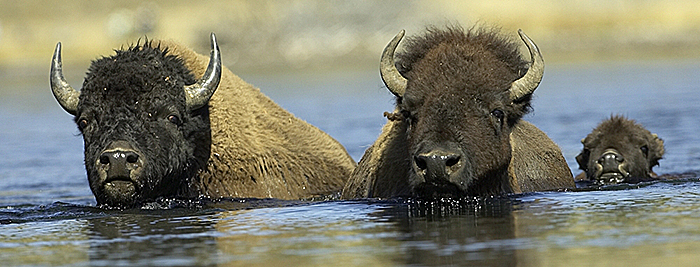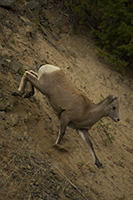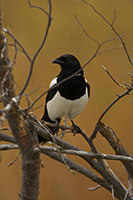
Bison river crossing along the Yellowstone near Hayden Valley

What you learn in one place can certainly be applied to another. Mary and I love Yellowstone, and I imagine we'll be returning to Yellowstone every fall for a long, long time. However, on our recent trip to Denali, which I incorrectly thought would be our last for quite a while, both of us photographed the park as if it would be the last time we'd be there. Consequently, we took nothing for granted and we photographed it harder, more thoroughly, and with more enthusiasm than I had done in all my previous visits. And the lesson we learned -- WE LOVED IT! So much so, in fact, that we immediately rescheduled another trip for 2007 -- we simply enjoyed it that much.

 Our 2006
Brochure is now on-line.
Our 2006
Brochure is now on-line.That message -- to shoot everything, to shoot Yellowstone as if we'd never be returning, was the message we wanted to convey to our tour participants and the mode of operation that we planned to follow for our 2005 Yellowstone Fall Photo Tours. At that, we succeeded incredibly well, and I honestly feel that this year's trips were the most enjoyable we've had in a long time, and ranks among the best ever. We didn't see a grizzly, and only filmed a few black bears on the first trip, but our coverage of the entire park, and the quality of the shooting we had, was simply spectacular.

As we usually do, we had two back-to-back tours, with one group comprised of six new people, including two extremely talented shooters from the Czech Repulbic and from Slavia, and the second group with eight veterans and only two new people -- making for a great mix of people for us. Both weeks started with a visit to Swan Lake Flats where we had, each week, an entirely differently shooting experience with the resident Trumpeter Swans. On the first week, the birds were not close, but while we filmed the hillsides and mountain backgrounds around the lake, the swans decided to take flight -- a rather rare event to see. The birds flew tightly together, but as they slapped their way across the water to take off they eventually separated, giving us a great series of take-off images.
We had wonderful luck with coyotes on both trips, and we filmed mousing -- when a coyote homes in on a hidden pocket gopher with radar-like ears -- and leaps high to pin or to stun the rodent with its paws. One coyote, which we almost missed because we left an overlook just seconds before the coyote appeared in view, walked right passed us, and another moused several times near the road.



One might think that repeating the same trip a second week could be boring, monotonous, or repetitious, but aside from the swans, the two trips were extremely different in the shooting opportunities. On Tour One, we had spectacular skies for bison panoramas near Lamar Valley, while on Tour Two, in the same area, we had some of our best shooting opportunities, ever, for pronghorn antelope. We had some very good opportunities in that some location on the first Tour, but on the second a pair of pronghorns attempted to mate -- something I'd never seen before, and as we followed the animals, paralleling their route, the adults and the fawn ran right up to us, so close that all three presented ONLY headshots for a few minutes -- they moved in that close. After a few minutes they wandered off, jogging to another hillside, and finally returning to the area where we had started our filming.



We had three Bison river crossings in one day on the first tour, and much more elk activity, as strangely enough, the weather warmed considerably during the second week and mating ardour waned. However, on the second tour we filmed one of the biggest elk, a 7x7, we'd ever seen, in a location where elk are normally skittish and where we'd never successfully filmed before, but this bull, in the foggy, diffused light of a frosty morning, performed beautifully.


On Tour One we had a wonderful roadside experience with a herd of Big Horn Sheep ewes and lambs, which crossed the road on the way to drink in the Tower Creek, and then returned up the cliffs to our roadside vantage. It's rare to have a chance to shoot sheep as they run downhill, scrambling down nearly vertical slopes, but we had the chance to shoot at least six doing just that! The sheep moved so close that we had to constantly back up, and getting headshots of the ewes and lambs was easy.
 Birds
were particularly rewarding this year. At one location, near a
fairly fresh wolf kill, magpies gathered, and were incredibly
tame as they hunted for scraps from a nearly completely-devoured
young elk carcass. Stellars Jays, Canada or Gray Jays, Hairy Woodpeckers,
Mountain Bluebirds, Common Ravens, Canada Geese, and Dippers were
photographed; with one Dipper performing wonderfully for the four
photographers who joined me at creekside to film the bird hopping
from rock-to-rock at close to minimum focusing distance.
Birds
were particularly rewarding this year. At one location, near a
fairly fresh wolf kill, magpies gathered, and were incredibly
tame as they hunted for scraps from a nearly completely-devoured
young elk carcass. Stellars Jays, Canada or Gray Jays, Hairy Woodpeckers,
Mountain Bluebirds, Common Ravens, Canada Geese, and Dippers were
photographed; with one Dipper performing wonderfully for the four
photographers who joined me at creekside to film the bird hopping
from rock-to-rock at close to minimum focusing distance.
 Our
batting average for finding Great Gray Owls is about 50%, which,
when you consider that some of our closest friends who spend months
in Yellowstone or who visit the Park throughout the year have
only seen 1 or 2 (and only with us), is a darn good average. On
Tour One we missed the owls, but on Tour Two friends of ours had
spotted one and gave us pretty clear directions on where to look.
While searching, Mary spotted (and don't ask me how!) FIVE Gray
Wolves resting in a rendevous location in some pines. The spot
was nearly 2/3rds of a mile from the car but she raced back, radioing
the group to get their gear and be ready to go on a fast hike,
as dusk was approaching. We assembled and started a brisk forced
march, with Mary leading and literally zipping up the hills. I
was right behind her and couldn't believe her pace, but as she
said later, she was really excited to see the wolves and wanted
us all to see them before they took off on their evening hunt.
En route, we found the owl! This, the largest owl in North America,
was perched on a snag only a few feet above the ground, and I
suggested that it might be more prudent to work the owl -- a sure
thing -- than to continue racing toward the wolves. As it turned
out, Mary, me, and Travis reached the wolves just as they got
up, socialized, and moved out for their evening foray. The shots
were distant and not too great, but the experience was spectacular.
Travis, James, and I set out to see if we could spot the wolves
again after they moved off, but where unsuccessful, but we did
have luck with the owls -- as did everyone -- which we filmed
almost to sunset where we were serenaded by the wolves -- a wonderful
ending to the day.
Our
batting average for finding Great Gray Owls is about 50%, which,
when you consider that some of our closest friends who spend months
in Yellowstone or who visit the Park throughout the year have
only seen 1 or 2 (and only with us), is a darn good average. On
Tour One we missed the owls, but on Tour Two friends of ours had
spotted one and gave us pretty clear directions on where to look.
While searching, Mary spotted (and don't ask me how!) FIVE Gray
Wolves resting in a rendevous location in some pines. The spot
was nearly 2/3rds of a mile from the car but she raced back, radioing
the group to get their gear and be ready to go on a fast hike,
as dusk was approaching. We assembled and started a brisk forced
march, with Mary leading and literally zipping up the hills. I
was right behind her and couldn't believe her pace, but as she
said later, she was really excited to see the wolves and wanted
us all to see them before they took off on their evening hunt.
En route, we found the owl! This, the largest owl in North America,
was perched on a snag only a few feet above the ground, and I
suggested that it might be more prudent to work the owl -- a sure
thing -- than to continue racing toward the wolves. As it turned
out, Mary, me, and Travis reached the wolves just as they got
up, socialized, and moved out for their evening foray. The shots
were distant and not too great, but the experience was spectacular.
Travis, James, and I set out to see if we could spot the wolves
again after they moved off, but where unsuccessful, but we did
have luck with the owls -- as did everyone -- which we filmed
almost to sunset where we were serenaded by the wolves -- a wonderful
ending to the day.
Both trips set 'records' this year. Normally -- well, every tour we've ever done in Yellowstone until this year! -- on our Portfolio Night we order pizzas and beer and have an in-the-room pizza party while we look at images. This year, because of the intensity of the shooting on that day, we had breakfast and lunch so late in the day that no one needed dinner, and we reviewed wonderful portfolios shortly after returning to the motel. Days were long; on Tour Two we beat Tour One's new record by arriving in one evening at 8PM or so -- we were still at Canyon, an hour from Gardiner, at sunset on the afternoon we shot the great gray owl and the wolves.



 While
our tour is timed to coincide with the fall rut of elk, and should
catch courting activity with moose, bison, mule deer, and pronghorn,
Yellowstone offers plenty of photo subjects and we try to shoot
as many of these as we can. Two of our favorite locations is the
Mute Dog Forest, a beautiful forest of dead trees in a meadow
of red grasses, and an aspen groove in the northern part of the
Park, and we generally get to spend some quality time at both
locations working on landscapes, patterns, and abstracts. This
year the weather cooperated wonderfully, and we had the right
light, or temperatures, for where ever we happened to be. At one
location, two nice Mule Deer Bucks showed up while we filmed,
but after a short stint in the open they wandered into the forest.
I followed, and after a few minutes they grew quite used to me,
so I headed back to the group and four photographers followed
me back in search of the deer. Incredibly, we found them again,
and a few of the shooters were rewarded with head shots!
While
our tour is timed to coincide with the fall rut of elk, and should
catch courting activity with moose, bison, mule deer, and pronghorn,
Yellowstone offers plenty of photo subjects and we try to shoot
as many of these as we can. Two of our favorite locations is the
Mute Dog Forest, a beautiful forest of dead trees in a meadow
of red grasses, and an aspen groove in the northern part of the
Park, and we generally get to spend some quality time at both
locations working on landscapes, patterns, and abstracts. This
year the weather cooperated wonderfully, and we had the right
light, or temperatures, for where ever we happened to be. At one
location, two nice Mule Deer Bucks showed up while we filmed,
but after a short stint in the open they wandered into the forest.
I followed, and after a few minutes they grew quite used to me,
so I headed back to the group and four photographers followed
me back in search of the deer. Incredibly, we found them again,
and a few of the shooters were rewarded with head shots!
Breakfastes and lunches were always served afield, with Mary cooking up something hot for every lunch, including barbeque and chili on two days, and I always suggested people have their equipment ready because pan-handling animals and birds often stop by. It is illegal to feed wildlife in Yellowstone, as it is a sure way to eventually attract bears and a fed bear is a dead bear, but there is still enough illegal feeding occuring that the birds and chipmunks always gather at a picnic site. At one of our breakfast locations on our first trip our Czech friend spotted a PINE MARTEN, a large arboreal weasel. Rusty's English was pretty limited so as he spotted it he could only say 'Martes martes,' the marten's scientific name. I looked up just in time to get the briefest of glimpses, marking only the second time in my life I've seen a marten.
 On
our next trip I grabbed some left-over pizza from our Sunday welcome
meal and headed to a spot to watch for pika, just a few hundred
yards from where we'd had the marten the week before. I spotted
one fairly uncooperative pika that afforded a couple of shots
-- not enough to warrant radioing the group in -- when I spied
a brilliant chestnut patch in the distant rocks. I knew immediately
that it was the pine marten, which proceeded to slither through
the rocks to investigate me. I was using a 500mm lens and the
marten, with only its paws and head poking over a boulder, was
too close to focus! For several minutes, and while I radioed Mary
to send up the troops for photos, the marten perched there, rubbing
its chin on the rock. It moved furtheroff by the time the tour
participants arrived but everyone saw it, and several got some
great shots of this incredibly difficult to photograph mammal.
For me, seeing a marten this close, and getting some shots, was
the highlight of my week of shooting.
On
our next trip I grabbed some left-over pizza from our Sunday welcome
meal and headed to a spot to watch for pika, just a few hundred
yards from where we'd had the marten the week before. I spotted
one fairly uncooperative pika that afforded a couple of shots
-- not enough to warrant radioing the group in -- when I spied
a brilliant chestnut patch in the distant rocks. I knew immediately
that it was the pine marten, which proceeded to slither through
the rocks to investigate me. I was using a 500mm lens and the
marten, with only its paws and head poking over a boulder, was
too close to focus! For several minutes, and while I radioed Mary
to send up the troops for photos, the marten perched there, rubbing
its chin on the rock. It moved furtheroff by the time the tour
participants arrived but everyone saw it, and several got some
great shots of this incredibly difficult to photograph mammal.
For me, seeing a marten this close, and getting some shots, was
the highlight of my week of shooting.
Shooting digitally, we had the opportunity to review images, and, more importantly, to try digital techniques like panorama stitches and exposure composites. The image below was a digital stitch, but the coyote and the moose are simply crops of large file images -- which in fact illustrates the flexibility and the versatility of digital.
We'll be offering two Yellowstone Photo Tours next year, and the dates are already set, but we're also offering something brand new, too. For the first time we'll be offering both a pre-shoot before our first Yellowstone tour, and a post-shoot after our second Yellowstone tour, at ANIMALS OF MONTANA (trip report), (or see Brochure)a captive animal shoot where we'll be filming grizzly bears, black bears, pumas, wolves, foxes, and more. Mary and I just did a scouting shoot there, and I was incredibly impressed -- I only shot one animal, a full-grown grizzly, but it was the most successful and exciting captive/controlled hoot that I've ever done. We were hooked. If you're interested in either tour, please contact our office immediately. We anticipate these trips filling fast!












